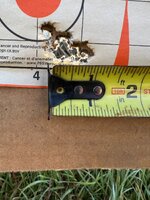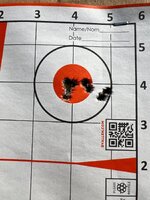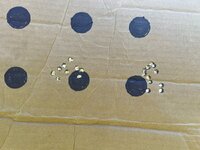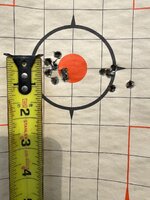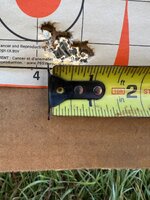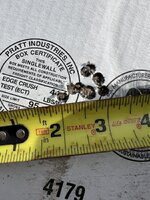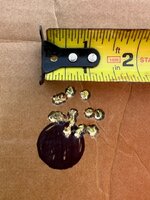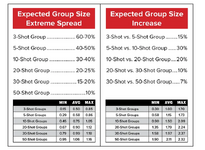Im becoming very confused.
If nodes dont exist, then any good bullet with any charge weight, any seating depth for a particular rifle shoots the exact same.
If so then what are we doing?
Im also confused how a method that is clearly working can be so easily dismissed.
What are we doing, indeed. Query whether reloading is actually "worth it," but that's a different topic. I'm presuming a good faith desire to understand an opposing view point, and so I will try to help with that.
First, here are links to the Hornady podcasts mentioned a couple of times by others: Y
our groups are too small and
Your groups are still too small. There are some important caveats to their claims that come through better in the second one: specifically, their testing is with Hornady bullets in Hornady-designed chambers like 6 ARC and 6.5 Creedmoor. (One might hypothesize, for example, that a VLD in a SAAMI-spec 300 Win Mag might be more sensitive to changes in seating depth than is a 6.5 Creedmoor with an ELDM, and I don't think Miles or Jayden would claim their testing rules that out). I don't treat the Hornady's information as gospel, but it is data-driven, thought provoking, and largely consistent with my own anecdotal experience chasing "nodes" and "best" loads that don't repeat on different days.
The big take-aways from those podcasts (going from memory here, so excuse me if I'm imprecise or miss something):
- You need to shoot 20 shots of a particular load before it begins to be statistically significant. More is better, though there is a point of diminishing returns. 10 shots starts to tell you something but still has significant variation you need to acknolwedge and so 20 is better. Anything less than 10 is a waste of time.
- Small changes in powder charge do not translate to substantial, verifiable changes in precision when you shoot statistically valid samples. In fact, if anything, lower powder charges tend to be more precise than higher powder charges.
- Small (and not so small) changes in seating depth do not translate to substantial, verifiable changes in precision when you shoot statically valid samples. (Again, note caveat on bullet and cartridge types here).
- Common load development methods like OCW, Satterlee, etc. do not identify loads/nodes that are consistently better than other combinations of the same bullet-powder-primer-case. Instead, what you are seeing when you shoot "small sample size" groups is random variation that, while the groups appear different, is "within the noise" or true cone of fire and thus statistically not different.
So why do all of those load development techniques "work" to identify accurate loads world class shooters win matches with? The Hornady guys would respond because that so long as you're using using quality components and good reloading processes, about any method will work to identify a good load. The 1-shot, 3-shot, or 5-shot methods are giving you a "confirmation spiral" where you think you're picking "the best" load but what you're really doing is picking a good load that's statistically the same as the load next to it. And world class shooters are world class shooters.
So does this mean that all load development is a complete wast of time and you're just as well off picking a random combination? Not quite. But, in point of fact, you can pick random recipes of quality components and do quite well with them.
I think everyone would agree that individual barrels often exhibit a preference for certain bullets over others. This has certainly been my experience. So, picking a "good bullet" doesn't necessarily ensure your barrel will like that bullet as well as it likes another "good bullet." Also, I have seen barrels that show a preference (or distaste) for particular powders. I had a 30-06 that hated IMR 4451, for example, while another 30-06 and a 6.5 Creedmoor liked that powder just fine. One of my Grendel ARs (but not the other) strongly prefers TAC over most other powders (read all others I've tested) with 120/123 class bullets. And Bryan Litz demonstrated in one of his books that changing from one brand of match-grade primer to another in a particular rifle/load reduced velocity variation (ES/SD) measurably, although precision measured at 100 yards remained the same. I, on the other hand, have never seen primer selection make a difference (although I admittedly don't test it very often).
So coming back to seating depth: does it matter? To paraphrase Bryan Litz again, "in what cirumstances does it matter, and do those circumstances apply to you?" I can personally get sufficient accuracy for my hunting and limited match uses by selecting bullet-powder combinations with an almost randomly selected jump (I described my process in an earlier post ) that I do not feel the need to do seating depth testing/tuning. It takes a lot of components to prove that a particular seating depth is better than any other. It's just not worth it to me. Either that bullet-powder combination shoots in that barrel, or it doesn't. If the load is finicky about seating depth to stay "in tune," I don't want to deal with it in the field.
For the Benchrest and F-Class guys? Hey, if you want to shoot in their disciplines, go listen to their advice. And get out your checkbook.

